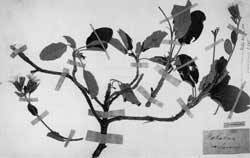Impact of Ottomans on Crete
Under Ottoman rule a wide variety of western European travellers visited the island. Their interests built on those already established in the Venetian period. Study of the flora of Crete continued. The French physician and botanist Tournefort, for example, collected plants from the White Mountains of Crete (south of Khania), a region already known for its rare endemic species (1701). He was followed by the English botanist John Sibthorp (1758-96), Professor of Botany at Oxford; who with John Hawkins and Ferdinand Bauer made a series of expeditions to the eastern Mediterranean between 1784 and 1795.
 Staehelina petiolata, a Cretan endemic, collected by John Sibthorp in 1786. © Oxford University Press |
On Crete he also collected Cretan plants, some of which survive today.
Such work formed the basis of his great work Flora Graeca (1806), and laid the foundations for our modern environmental understanding of the island.
 Staehelina petiolata , a Cretan endemic, drawn by Ferdinand Bauer ca. 1793. © Oxford University Press |
Travellers interested more in the people and the island as a whole reached new levels with the publication of Richard Pococke's A Description of the East and Some Other Countries (1743-5), which included an account of his visit to Crete (which he calls Candia) in 1739. He described life in the cities, noted styles of dress, and even local commercial conditions:
'The people of this part of Candia [i.e. Sphakia] are stout men and drive a great coasting trade round the island in small boats, by carrying wood, corn, and other merchandizes.'
Pococke was also the first English traveller to take a serious interest in the antiquities of the island, many of whose sites he correctly identified. One site, however, was to remain problematic for some time, and that is the Labyrinth. Classical texts stated that there was a complicated building called the Labyrinth at a place called Knossos on Crete. At Knossos itself, in north-central Crete, there was then almost nothing to be seen of the antiquities, though Pococke did examine a large Roman built tomb, known in his day by the Cretans as 'The Tomb of Caiaphas' (he was correctly dismissive of this identification).
Previous travellers had seen the tunnels of the ancient quarries near a site with obvious ancient ruins called Gortyn, in south-central Crete, and had decided that these must be the remains of the Labyrinth. He studied the ruins of Gortyn (a sketch plan had already been published by Tournefort), and the so-called Labyrinth nearby:
'Going about a mile further to the south west, we ascended the hills, and came near to the top of them, to what is called the Labyrinth; though that famous building, so renowned in history, was at Knossos, and no remains of it were to be seen in the time of Pliny [first century AD]. This place is nothing more than the quarry out of which the city of Gortynia was built.'
Pococke was indeed right that this was not the Labyrinth, which remained to be discovered at Knossos. (For further information on the myths associated with Crete, see Unit 2 Session 2 Lesson 2.)